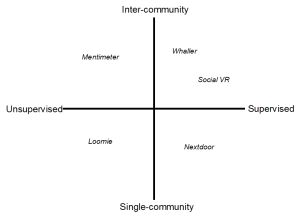
by Dr Salvador Alvidrez, Queen’s University Belfast
This is a guest article sourced by NICRC.
How Can Community Organisations Adapt During Lockdown?
The current Covid-19 pandemic has rushed the digital transformation of most everyday activities. However, whereas some activities can be done online, many others are practically impossible to be done remotely. Community relations work, for example, requires much time in outdoor activities and face-to-face communication. Then, how can community organisations adapt and keep up with their work during lockdown restrictions? Below are some recommendations about currently available online tools for community work.
Online Communities Built on Trust
Good relations between communities are generally built on the basis of trust, which in online settings would correspond to a fair management of information and communication exchanges. Community organisations not only promote communication among members of one single community but also between communities. However, communication should be supervised and regulated in order to maintain a solid structure of positive relations. Hence, two dimensions of community relations and communication regulation are proposed for the use of these online tools: the first axis goes from single-community to inter-community relations, whereas the second axis goes from unsupervised to supervised communication.

Quadrant 1: Communication between communities requiring supervision (top right).
For these cases, Whaller is a digital tool that allow users to build private (and secure) social networks in the form of “spheres” (e.g., “work”, “friends”), each representing a cluster of contacts that are not in touch with other spheres unless the administrator decides otherwise. Whaller has also a series of features that fit community work such as project management tools, video-conferencing, file-sharing, discussion boards, private messaging, and others. With this tool communities can be managed first as separate spheres and later as one global sphere.
Another less explored tool is virtual reality (VR) for social interactions. As VR is now accessible from mobile phones and a cheap cardboard headset, organisations can hold supervised inter-community interactions within virtual rooms created ad-hoc for activities. The advantage of VR over any other desktop interaction is that participants are immersed in a virtual space that simulates physical presence of self and others, providing a more realistic experience. Social VR is now available (for free) in mobile applications such as vTime, Rec Room, or Mozilla Hubs.
Quadrant 2: Communication within a single community requiring supervision (bottom right).
For this type, Nextdoor is an available option for creating a private social network based on the physical proximity of neighbours. In Nextdoor people can share posts of common interest for the neighbourhood (e.g., garage sale, nanny recommendations, crime reports), and for promoting local businesses (e.g., pharmacies, supermarkets). Although Nextdoor has been successful in promoting cohesion, there has been some cases in which racism and harassment have also been promoted. Therefore, this tool requires strict supervision of people trained in community relations.
Quadrant 3: Communication within a single community that does not require supervision (bottom left).
If community members seek for informal communication but they are shy or simply tired of using Zoom or Skype, LoomieLive is a good and free option. LoomieLive allows users to communicate in real time as 3D avatars using face-synch technology that imitates the user’s face gestures while speaking. Whereas this tool can also be used in the first quadrant, community members might also find it useful for their everyday online communication.
Quadrant 4: Communication between communities that does not require supervision (top left).
Mentimeter is a widely used tool to create online Powerpoint-like presentations. One of its features is that online participants can share anonymous responses to key questions, thus providing feedback in real time. For example, practitioners may deliver an online presentation with proposals about the fate of an old building that borders two communities and ask for feedback. Members in both communities can express their opinions in a free manner and in real time.